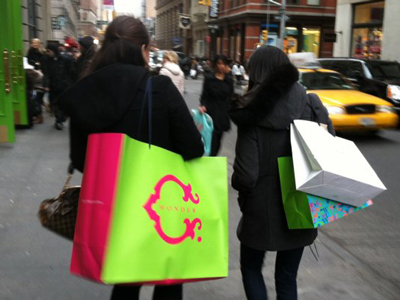
Henry Grabar in The Slate reports that it was ten years ago that the death of the suburban shopping mall was announced. This was the first year in fifty that no new malls were built in the United States. “Brick and mortar” retailing has been failing, when “The Limited, a women’s clothing store, shut down 250 stores and laid off 4,000 workers earlier this year. Sears Holdings will close 150 stores, including 108 Kmarts, and Macy’s will close another 100. As anchor stores close, more and more malls are entering foreclosure. Financial instruments composed of debt from mall deals are looking as risky as their counterparts in residential debt did before the housing crisis.”
E-commerce,the rise of Amazon and online shopping has taken some of the blame. While there is increasing employment in warehousing, “department stores; general merchandise stores; and sporting goods, hobby, book, and music stores” have lost jobs, with clothing stores severely hit the last few months. Ironically 71 per cent of workers in ” sales and related occupations live in the suburbs, according to the Brookings Institution, about 2 percentage points higher than the average for U.S. workers.”
What seems to be successful for retail is the mix of an urban “retail corridor” in cities, with “stores flanked by restaurants, bars, and other entertainment attractions”, close to mixed use density and good public transit. But while media has blamed internet shopping for the end of the suburban mall, retail may have been overbuilt. The challenge for suburban locations is finding alternative ways to create employment and repurpose lands to contribute to the tax base. As Leah McLaren writes in the Globe and Mail Canadians still have not caught up with online shopping. While 10 to 12 per cent of Americans spend on the Amazon shopping site, only 6 per cent of Canadians do. Colliers reports that “online shopping sales growth can be blamed for vacancy of roughly 14.8 million square feet of mall space between 2012 and 2014.” Given that indicator, shopping malls will be shrinking dramatically in Canada as well, as E-commerce catches on.
It is therefore no surprise that the Vancouver Sun writes that malls “are fighting for shoppers with one things their web rivals can’t offer: parking lots”, by using them for carnivals, concerts and food truck festivals. Tsawwassen Mills which has had spectacularly empty parking lots featured a carnival on site this month. They are also now running a “shopping shuttle” picking up prospective shoppers in downtown Vancouver for a day of mall shopping at the Mills. But will shuttles provide enough consumer traffic for that long drive in the face of the quick access of E-commerce and Amazon? Is this a portent of changing consumer tastes?
What seems to be successful for retail is the mix of an urban “retail corridor” in cities, with “stores flanked by restaurants, bars, and other entertainment attractions”, close to mixed use density and good public transit. But while media has blamed internet shopping for the end of the suburban mall, retail may have been overbuilt. The challenge for suburban locations is finding alternative ways to create employment and repurpose lands to contribute to the tax base. As Leah McLaren writes in the Globe and Mail Canadians still have not caught up with online shopping. While 10 to 12 per cent of Americans spend on the Amazon shopping site, only 6 per cent of Canadians do. Colliers reports that “online shopping sales growth can be blamed for vacancy of roughly 14.8 million square feet of mall space between 2012 and 2014.” Given that indicator, shopping malls will be shrinking dramatically in Canada as well, as E-commerce catches on.
It is therefore no surprise that the Vancouver Sun writes that malls “are fighting for shoppers with one things their web rivals can’t offer: parking lots”, by using them for carnivals, concerts and food truck festivals. Tsawwassen Mills which has had spectacularly empty parking lots featured a carnival on site this month. They are also now running a “shopping shuttle” picking up prospective shoppers in downtown Vancouver for a day of mall shopping at the Mills. But will shuttles provide enough consumer traffic for that long drive in the face of the quick access of E-commerce and Amazon? Is this a portent of changing consumer tastes?














One thing a checklist of positive economic and planning attributes even mixed use and transit access cannot provide to a private mall conversion is a 24 / 7 genuine community with a dominant public realm, like Copenhagen’s Stroget.
https://upload.wikimedia.org/wikipedia/commons/d/db/Aarhus_str%C3%B8g_med_juleudsmykning.jpg
Indeed inner city malls or street level retail or pedestrian zones can be very successful but only if taxation levels and rents are properly set. Many inner city street are clones of each other now due to escalating taxes and rents, driving out local specialty stores.
Tell this story to Surrey where brand new big box sprawl is being built right now. Perhaps not the traditional indoor mall, but certainly the same drive to parking lot surrounding a huge building model.
Author
Reblogged this on Sandy James Planner.
Lansdowne Park (which went into decline once Woodward’s, then Eaton’s, went bankrupt in the 1990s) has used its parking lot for carnivals, the Richmond Night Market and other events for many, many years.
Most mature malls which have seen development spring up around them over their life cycles are also looking at their monetizing their parking lots by developing on them.
The obvious examples are:
– Shape Properties’ Amazing Brentwood
– Shape Properties’ City of Lougheed
– (former) Ivanhoe Cambridge’s Oakridge Centre
– Anthem’s Station Square
– Larco’s Park Royal South (the small triangle not on Reserve land)
– Lansdowne Park – in planning stages
– Richmond Centre – in planning stages to replace the Sears building and parkade (plus some condos were built on the parking lot facing Minoru in the late 1990s(?))
On a smaller scale Safeways, IGAs and other supermarkets have gone from cavernous bent-wood beamed halls in seas of parking, to at-grade podium retail in mixed use projects with underground parking.
On an even smaller scale, strip malls along major arterials like Kingsway are being replaced with medium-scaled mixed use projects.
It’s all intensification – at different levels depending on the nature of the site.
Interesting view that local inner city malls or retail is dying too due to
A) excessive property taxes
B) no road tolls as online retailer use public roads free of charge !!
http://business.financialpost.com/fp-comment/lawrence-solomon-how-city-politicians-are-helping-amazon-destroy-your-favourite-local-retailers
Taxation & toll models matter !!